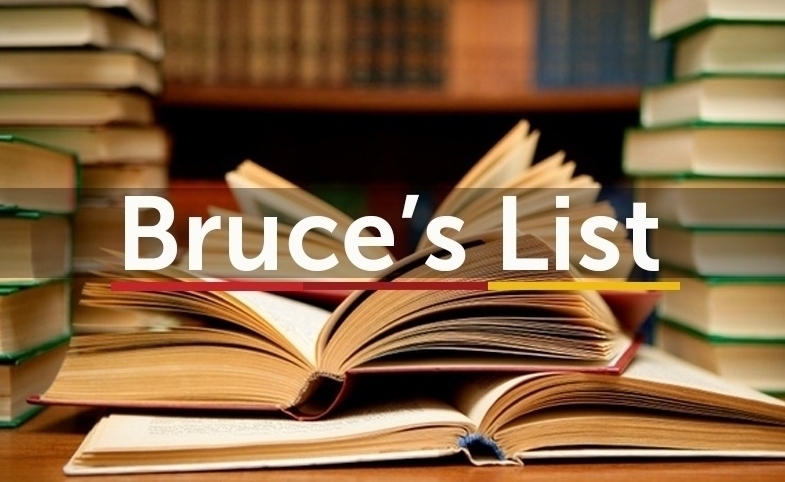
Latest Must-Reads in Public Diplomacy: September 2021
CPD Faculty Fellow Bruce Gregory has compiled a list of the latest must-reads in public diplomacy. Known affectionately at CPD as "Bruce's List," this list is a compilation of books, journal articles, papers and blog posts on a wide variety of PD topics.
Highlights from the latest list include:
Caitlin Byrne, “Truth, Lies, and Diplomacy,” Griffith Review 67, August 25, 2020. Byrne (scholar, former diplomat, and director of the Griffith Asia Institute) reflects on the meaning of trust in diplomacy’s private and public dimensions. She considers the challenges of diplomacy in the digital era, the “much needed ‘democratization’ of diplomacy,” difficulties faced by Australia as a middle power, and concerns created by authoritarian leaders feeding distrust about diplomacy and its practitioners. A brief, thought-provoking meditation by one of Australia’s best scholar/practitioners.
Nicholas J. Cull and Michael K. Hawes, eds., Canada’s Public Diplomacy, (Palgrave Macmillan, 2021). In his memoir thirty years ago, Canada’s prescient former ambassador to the United States Allan Gotlieb wrote that the “new diplomacy . . . is largely public diplomacy and requires different skills, techniques, and attitudes” (I’ll be with you in a minute, Mr. Ambassador: The Education of a Canadian Diplomat in Washington, 1990). In a pioneering speech at the US Institute of Peace in 1997, Canada’s deputy foreign minister Gordon Smith spoke to “The Challenge of Virtual Diplomacy.” In recent years, influential books and articles by Canada’s diplomats and scholars, including notably Daryl Copeland, Evan Potter, Janice Stein, and Andrew Cooper, have done much to shape study and practice in diplomacy’s public dimension. US practitioners and scholars have a lot to learn from their neighbors to the north. In Canada’s Public Diplomacy, Cull (University of Southern California) and Hawes (Fulbright Canada and Queen’s University) have compiled essays by experts on Canada’s public diplomacy past and present, current debates about “revitalizing” its global engagement, and issues in the use of digital tools, cultural diplomacy, international broadcasting, and other domains. Happily, the paperback edition is affordably priced at under $20. In addition to Cull and Hawes, contributors include: Andrew Cooper (University of Waterloo), Daryl Copeland (University of Montreal), Bernard Duhaime and Camille Labadie (Université du Québec à Montréal), Mark Kristmanson (formerly National Capital Commission), Evan Potter (University of Ottawa), Sarah K. E. Smith (Carleton University), Stefanie von Hlatky (Queen’s University), and Ira Wagman (Carleton University).
Geoffrey Wiseman, “What Do Diplomats Do Between Cocktail Parties.” CPD Blog, USC Center on Public Diplomacy. In this brief review, Wiseman (Professor and Endowed Chair in Applied Diplomacy at DePaul University’s Grace School of Applied Diplomacy) describes Australian diplomat Sue Boyd’s memoir Not Always Diplomatic: An Australian Woman’s Journey Through International Affairs (2020) as “a little gem.” His assessment makes several excellent points. Boyd’s successful career in the once overwhelmingly male-dominated Australian foreign service illuminates countless ways in which diplomats, especially at the ambassadorial level, are agents of soft power and public diplomacy. She demonstrates how the best diplomatic memoirs contribute to a better understanding of diplomacy, the foreign policy process, and the advisory role of diplomats. Her odyssey shows again the value of inter-cultural competence and networking skills. Scholars and practitioners need more memoirs that bridge conceptual and operational gaps and drive home the reality that public diplomacy is now mainstream.
Phillip Arceneaux, “Information Intervention: A Taxonomy & Typology for Government Communication,” Journal of Public Diplomacy, Vol. 1, No. 1, 5-35. Arceneaux (Miami University) tackles the enormous task of sorting out definitions, terms, and types of core behavior in government communication. He settles on a typology of four methods of “Information Intervention” – public diplomacy (PD), public affairs (PA), psychological operations (PSYOP), and propaganda. They are meant to categorize “who communicates with what audience, in what manner, with what intent, and with what desired outcomes.” He classifies methods in a taxonomy: PD and PA as “information politics,” PSYOP and propaganda as “information operations.” His research is grounded in semi-structured in-depth interviews with 18 leading diplomacy and communication scholars. Their views are summarized in multiple categories: actors, manner of communication, target audience, method for content creation, model of communication flow, end goal intent, and policy outcome. Arceneaux’s paper is a thoughtful and well-organized analysis. He prompts many questions and opens the door to further inquiry – by practitioners and scholars – as actors multiply, transnational issues become more complex, boundaries both blur and remain necessary, and diplomacy becomes more whole of government and whole of society.
The full list for this edition of Bruce's List can be found here.
Visit CPD's Online Library
Explore CPD's vast online database featuring the latest books, articles, speeches and information on international organizations dedicated to public diplomacy.
Popular Blogs
-
November 3
-
November 5
-
November 13
-
November 25
-
December 17







